
Are you looking to harness the power of Google Ads to promote your business? Maybe you don’t know how to write great content of a responsive search ad, or you are looking for some ideas to improve ad copy that you already have running in your Google Ads account.
Either way, we have you covered.
In this article, we’ll explore everything you need to know about Google responsive search ads to help you reach your goals and maximize your marketing budget.
Let’s dive in and boost your online presence with responsive search ads!
What are responsive search ads?
Responsive search ads were first introduced by Google in 2018, and these ads use machine learning algorithms to combine various headlines and descriptions dynamically. The overlap of machine learning and better user control over advertising means that your small business can display the most relevant and high-performing combinations are displayed to users.
As a business owner, leveraging responsive search ads can drive higher ROI for your search campaigns. This innovative ad format simplifies the process of ad creation and optimization, allowing you to focus on what truly matters – growing your business.
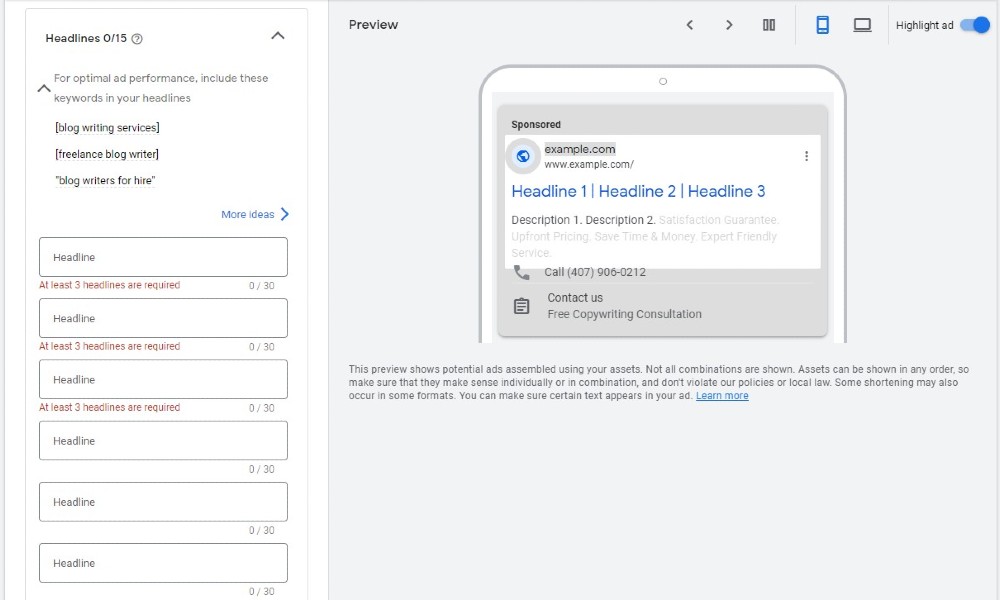
You empower Google’s algorithm to craft the most effective ad variations based on user behavior and preferences by providing multiple headlines and descriptions.
This means that your business can expect improved ad performance, increased click-through rates, and a higher return on their advertising investments if you use responsive search ad to their full potential. Embracing this cutting-edge technology will undoubtedly give you a competitive edge and help you stay ahead in the ever-evolving world of digital marketing.
How do responsive search ads work?
Responsive Search Ads (RSA) allow you to harness the power of machine learning to optimize ad performance to drive qualified traffic to your site and boost your ROI.
You’re allowed up to 30 characters for headlines and 90 characters for descriptions. You can also add other features like images to your ads to help make each ad as powerful as possible.
| Ad component | Responsive search ad |
|---|---|
| Headlines | Enter 3-15 headlines. These appear at the top of your ads. |
| Headline Lengths | Up to a 30-character limit |
| # of Headlines Shown | Up to 3 (based on character length) |
| Descriptions | Enter 2-4 headlines. These appear in the headlines and display URL. |
| Description Length | Up to a 90-character limit |
| # of Descriptions Shown | Up to 2 (based on character length) |
| Path URL | Enter 2 display paths. These appear in the green text under your headline. |
| Path URL Length | Each path can be up to 15 characters each. |
| Final URL | This is where your audience will go after they click on an ad. |
With the capacity to create up to 15 headlines and four descriptions, you’re armed with a powerful arsenal of ad variations – a whopping 43,680 potential variations that Google’s algorithm can choose from to help deliver the best message to your audience.
By feeding Google lots of data, you can fuel Google’s machine-learning capabilities to boost your ad performance, resulting in higher click-through rates and conversions.
Here is a quick overview of the different components of a responsive search ad so you can fill out all available information to make your ads as strong as possible.
14 Google Responsive Search Ads best practices
As a small business owner, leveraging the power of responsive search ads on Google is crucial for your online marketing success. To help you navigate this dynamic advertising landscape, we’ve compiled 14 essential best practices.
These guidelines will empower you to create captivating, effective ads that drive customer engagement and boost your bottom line.
Before we dive into best practices to build great ads, I think it’s important to note that you can use create great Google Ads with ChatGPT and Bard. These AI tools can provide ideation, organization, and direction to help you write amazing ad copy.
Now with that out of the way, let’s take a look at the the best ways to write great responsive ads today!
1. Complete all fields for your responsive ads
If you want to make the most out of your Google responsive search ads, one tip you want to take advantage of is completing all the available fields. This might seem like a no-brainer, but you’d be surprised at how many people leave sections on their ads blank.
While it might be tempting to leave some of these fields blank or fill them in with generic information, you’ll get better results if you take the time to complete everything that you can to help your ads stand out and give Google the information it needs to understand what your business offers.
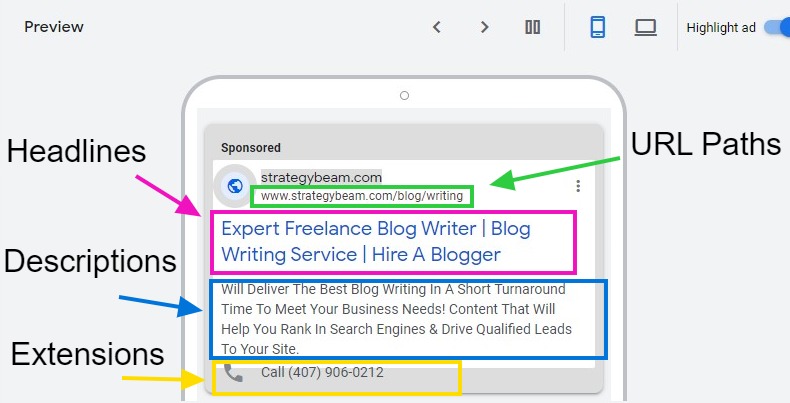
Throughout the years, I have seen that Google rewards users when they fill out as much information in each ad as possible, including:
- 15 headlines with unique and enticing content
- 4 descriptions that provide a clear overview of your products or services.
- 2 URL paths
Why is this so important? For starters, Google’s algorithm uses all this information to determine when and where to show your ads. If you leave fields blank, you miss out on valuable opportunities to reach potential customers. You can find this information as you review your PPC report each month, so be sure to include that step in your monthly review process or talk to your outsourced Google Ads provider to find more information as you build your ad strategy.
Additionally, by providing more detailed and specific information about your business, you’re more likely to attract the right audience and increase conversions. Simply filling out all available information on your ads helps Google show your ads to more qualified customers, and each customer who sees your ads will be more likely to click on the ad.
2. Include keywords in your headlines
As a small business owner, you’re always looking for Google Ads tips to get the most out of your marketing budget. You do this by ensuring that your ads appear to the right people at the right time, and this is accomplished by using keywords in your headlines.
To start, identify the most relevant keywords for your target audience. These are the terms your potential customers are likely to search for when looking for your products or services.
Next, craft compelling headlines incorporating these keywords, making sure they sound natural and engaging. Don’t keyword-stuff the headlines, and make sure you look at your keywords report to see what keywords are generating the most impressions and use those keywords in the ad copy.
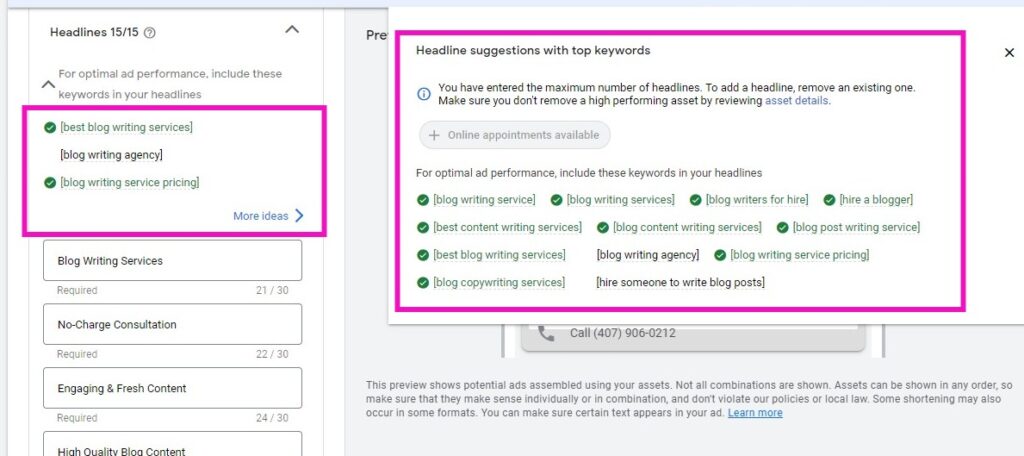
Adding keywords to your headlines helps Google understand what you offer so your ads will show more often, and your audience will see the keyword they just typed and know that your products or services are what they are looking for.
These factors can help improve the click-through rates (CTR) of your ads, drive more qualified leads to your landing page, and help you boost conversions. All of these benefits are easy to achieve by just adding the right keywords to your headlines!
Remember, with responsive search ads, you can create multiple headline variations. So, feel free to experiment with different keyword placements and combinations. Google will automatically test and display the best-performing headlines to your audience.
3. Write concise and distinctive headlines
A good Google responsive search ad headline should be relevant, specific, and attention-grabbing based on the needs of your audience.
It should convey what your business offers and why it’s the best choice for the customer.
Avoid using vague language or trying to be too clever, as this can confuse potential customers and make them less likely to click on your ad. People who click on Google Ads are in a hurry to find a solution, so make sure you speak to the specific needs of your audience to generate qualified clicks to your website.
By catching the attention of potential customers and highlighting your unique value proposition, you’ll be more likely to convert clicks into sales. Here are some simple best practices to keep in mind as you write your responsive search ads:
- Keep it short: Limit your headline to 30 characters or fewer to ensure it displays correctly on various devices. Focus on the essential message you want to convey.
- Be specific: Use numbers or statistics to create a sense of urgency and credibility. For example, “Save 50% Today” is more compelling than “Big Sale.”
- Highlight your unique selling proposition (USP): What sets you apart from your competitors? Emphasize this in your headline to grab attention and entice clicks.
- Use action verbs: Start your headline with a strong verb to encourage action, such as “Discover,” “Boost,” or “Transform.”
- Use numbers and symbols: Including numbers and symbols in your headlines can make them more eye-catching and easier to read. For example, “Save 50% on Your Next Purchase” or “Free Shipping on Orders Over $50.”
4. Make each headline and description unique
While Google gives you lots of opportunities to share your message with 15 headlines and 4 descriptions, you need to be intentional about each word you use in your ads.
Diverse headlines and descriptions allows Google’s algorithm to mix and match the best-performing combinations tailored to your target audience through Google’s machine learning technology.
Remember, your responsive search ads need to speak directly to your audience, so make it personal, relatable, and concise. Implementing this simple yet powerful tip will help elevate your responsive ads. Here are some tips to help you create ads that resonate with potential customers and drive more sales:
- Think like your customer: Before you start writing your headlines and descriptions, put yourself in your customer’s shoes. What are they looking for? What questions do they have? By understanding your target audience, you can create headlines that will catch their attention and descriptions that will answer their queries.
- Highlight your unique selling proposition (USP): What sets your business apart from your competitors? What do you offer that they don’t? Make sure your headlines and descriptions clearly communicate your USP. This will help you stand out in a sea of search results and make a strong impression on potential customers.
- Use emotional triggers: People don’t buy products or services based on logic alone. They buy based on emotions. Use words that tap into your audience’s emotions, such as “exciting,” “transformative,” or “life-changing.” This will help your ads connect with your audience on a deeper level and encourage them to take action.
- Be clear & concise: Remember that people are often scanning search results quickly. Make sure your headlines and descriptions are clear and to the point. Avoid jargon or buzzwords that might confuse your audience. Instead, focus on communicating your message in a way that is easy to understand and compelling.
5. Vary up your headlines and descriptions
When you create a Responsive Search Ad, you’re giving Google several different headlines and descriptions to choose from. The algorithm will test different combinations to see which ones perform the best.
So, suppose you have variations in your headlines and descriptions. In that case, you’ll increase the likelihood of your ad showing up for a broader range of search queries and also make your ad more engaging and relevant to potential customers.
But don’t just vary up your headlines and descriptions for the sake of it. Be intentional and test different combinations to see what works best for your business. You can try different tones, benefits, features, calls to action, and more to find what resonates with your target audience.
Be sure to use a range of headlines and descriptions in each ad to feed Google the information it needs to show your best ads to your target audience.
- Get creative with your headlines: Feel free to mix things up with your headline variations. Try different wording, focus on different benefits, and experiment with calls to action that resonate with your target audience.
- Use emotion to connect with your audience: People make decisions based on their emotions, so try to appeal to their feelings with your headlines and descriptions. Use powerful words like “amazing,” “life-changing,” and “incredible” to create a sense of excitement and urgency.
- Test, test, test: The beauty of responsive search ads is that Google will automatically test different variations of your ad copy. However, you can still help the process by testing your own variations. Try different headlines, descriptions, and calls to action to see what resonates best with your target audience.
6. Create themes for your headlines and descriptions
One of the best ways to create compelling headlines and descriptions for your responsive search ads is to use different types of content in your headlines.
This is because different people are looking for different information as they shop, and you can meet the needs of your audience if you include a range of information to show the value of your products or services.
Now, you might be thinking, “what types of content should I use in my headlines and descriptions?”
Good question.
Here is a quick overview of 8 different “themes” that you should include in your headlines to grab the attention of your audience and show speak to a rank of needs:
| Headline/Description Feature | Description | Example |
|---|---|---|
| Keywords | These are the words or phrases people use when searching for something on Google. | If you’re a florist in San Francisco, including keywords like “florist in San Francisco” or “flower delivery in San Francisco” in your ad headlines can help make your ad more relevant to people searching for those terms. |
| Features | These are the characteristics or qualities of your product or service to help you stand out from your competitors. | If you’re selling a new smartphone, highlighting features like a high-resolution camera or long battery life can help your ad stand out from other smartphone ads. |
| Benefits | These are the positive outcomes or results that your customers can expect from using your product or service. | CIf you’re selling a meal delivery service, highlighting benefits like time-saving or healthy meals can help persuade potential customers to click on your ad. |
| Price Comparison | If your product or service is competitively priced compared to similar offerings, you can include price comparison information in your ad headlines to persuade price-sensitive consumers to click on your ads. | If your online store offers lower prices than your competitors, highlighting that fact in your ad headlines can help convince potential customers to choose your offering. |
| Brand Messaging | This refers to the message that you want to communicate about your brand and make your ads more memorable. | If you’re a luxury brand, using ad headlines that communicate exclusivity or quality can help establish your brand identity. |
| Social Proof | This is evidence that your product or service is trusted and well-regarded by others. | Include items like customer reviews or ratings, in your ad headlines can help build trust and credibility with potential customers. |
| Calls to Action (CTA) | CTAs are clear and compelling calls to action in your ad headlines and descriptions that can help drive clicks and conversions. | These instructions encourage potential customers to take a specific action, such as “Shop Now” or “Learn More.” |
| Competitive advantages | These are the advantages that your product or service has over the competition. | Highlight your competitive advantages in your ad headlines can help persuade potential customers to choose your offering over others. |
Using a mix of these content types, you’ll be able to create themes for your headlines and descriptions that will appeal to a range of audiences.
But why is this so important? The answer is simple – people have different reasons for searching online. Some are looking for specific features, others want to know about pricing, and still, others are looking for social proof or competitive advantages. By using a mix of content types in your responsive search ads, you can feed a range of information to Google and your audience.
The result?
Your ads will be more relevant to your target audience, which means they’ll be more likely to click through to your website. And as we all know, more clicks mean more potential customers, which can ultimately lead to increased sales and revenue.
7. Reference ad strength score before publishing
Before publishing your ad, it’s important to take a look at your ad strength. This metric gives you an idea of how likely your ad is to perform well in the auction process.
Taking a quick look at your ad strength before publishing the ad will help you identify areas where your ad needs improvement by checking your ad strength. This can be anything from tweaking your headlines to refining your ad copy. You should aim for ads with a strength of “Excellent” or “Good” before publishing.
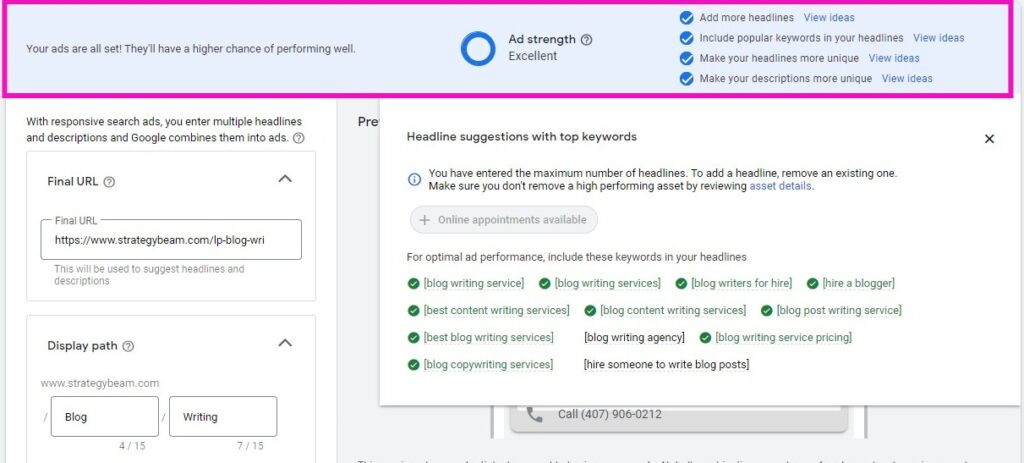
A strong ad is more likely to be shown to potential customers, increasing their chances of clicking through to your website. You can combine this information with insights from the Google Ads Auction Insights report to help you write better text ads. Here are some ideas to help you write stronger responsive ads:
- Upload at least four headlines and two descriptions: Google needs data to show the best combinations of headlines and descriptions, so be sure to upload at least four headlines and two descriptions for each responsive ad.
- Include keywords: You can improve the strength of your ads by adding keywords in the headlines and descriptions for each ad. This will help Google understand what you offer and reduce your spending on each click while driving more qualified traffic to your website.
- Use Persuasive Language: Use language that is persuasive and compelling. Highlight the benefits of your products or services and use words that inspire action.
- Test and Refine: The best way to improve your ad strength is to test and refine your ads over time. Experiment with headlines, ad copy, and keywords to see what works best for your business.
8. Highlight unique selling points
Now that your ads are getting seen by potential customers searching for your targeted keywords, it’s time to turn those prospects into paying customers.
But how do you do that?
Well, one tip is to focus on selling the benefits of your products or services rather than just listing their features. When someone clicks on one of your ads, they are likely near the purchasing decision. This means they have done their homework and know what they need, but now they are looking for the best option to obtain that product or service.
You can make the most of your limited responsive ad space by focusing on the benefits that you offer your customers. Use your headlines and description lines to show your customers how you can make their lives easier, better, and more fulfilling by solving their problems.
You’ll be more likely to capture their attention and win them over as loyal customers by highlighting the benefits. Here are some simple tips that you can use to write more compelling ads:
- Know your target audience: To highlight your unique selling points effectively, you need to know who your audience is and what they want. Identify your target audience’s pain points and desires, and make sure your USPs align with them. Use language that resonates with them and speaks to their needs.
- Focus on benefits, not just features: While it’s important to highlight the features of your product or service, it’s even more critical to emphasize the benefits your customers will receive. What problems will your product or service solve for them? How will it make their lives easier or better? Emphasize these benefits in your ads.
- Be specific and quantifiable: Avoid vague statements like “we’re the best” or “we have great customer service.” Instead, provide specific details and data that demonstrate your USPs. For example, “Our product has helped over 10,000 customers lose weight” or “Our customer satisfaction rating is 95%.” Specifics like these add credibility to your claims and help customers trust your brand.
9. Add a CTA to your descriptions
If you want to maximize the effectiveness of your ad, you need to include a clear and compelling CTA in the description. This is because your CTA prompts your readers to take action and this can help drive more clicks and conversions through your ads.
To write a great CTA, you need to focus on what benefits the user will get from clicking on your ad. Here are ideas to keep in the back of your mind as you write CTAs for your responsive search ads:
- Use action-oriented language: Make your call to action (CTAs) clear and direct by using verbs that encourage action. For example, “Shop now”, “Sign up today”, or “Book a consultation”.
- Highlight benefits: Use your CTA to highlight the benefits of your product or service. This will help to encourage potential customers to take action. For example, “Get 20% off your first order” or “Transform your business today”.
- Use urgency: Create a sense of urgency by using words like “limited time” or “act now”. This can help to motivate potential customers to take action before they miss out.
- Match your CTA to your landing page: Make sure that your CTA is consistent with the action you want potential customers to take on your landing page. This will help to create a seamless experience for the user and increase the chances of conversion.
10. Be cautious when pinning headlines or descriptions
When it comes to creating Google responsive search ads, pinning headlines can be a great way to ensure that the most important parts of your ad always show. But, you also need to be cautious when using this option because we have found that pinning headlines or descriptions can lower the CTR and visibility of your ads.
Pinning the headline or description can help your campaign, but you should avoid this feature until you are comfortable with Google Ads.
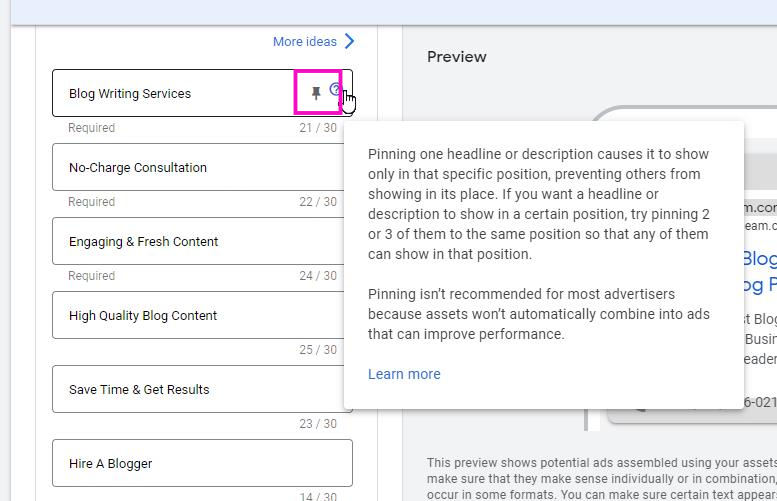
One of the reasons that pinning headlines and descriptions impacts your campaign is that this approach limits the testing that Google performs on your ad. When you pin just one headline, Google’s testing opportunities drop by over 75%. And if you pin two headlines, testing opportunities decrease by a staggering 99.5%!
This means that you may be missing out on opportunities to improve the performance of your ad. Instead of pinning your headlines, try to create diverse and flexible ads. By allowing Google to test different variations of your ad, you can find the combination that resonates best with your target audience.
11. Upload images to each ad
When writing a responsive search ad, Google gives you the power to upload images to each ad. Images can help your ad stand out among the competition, and they provide visual cues to help potential customers quickly understand what your business is all about.
Including images in your responsive search ads can help you showcase your products or services better.
For example, if you use Google Ads for small business to sell handmade crafts, including images of your products can give potential customers a better idea of what you offer and increase the likelihood that they’ll click through to your website.
Google has specific guidelines that you need to follow when you add an image to your responsive ads, but here are some tips you can use to make the most of this feature:
- Upload at least 3-5 images: Having a variety of images can help capture the attention of potential customers and make your ad stand out from the competition.
- Use high-quality images: Blurry or low-quality images can make your ad look unprofessional and can turn off potential customers. Make sure your images are high-resolution and look sharp.
- Show off your products: If you’re advertising a product, make sure to include images that showcase its features and benefits. This will give customers a better idea of what they can expect when they purchase from you.
- Be creative with your images: Be bold and think outside the box and try something different. Experiment with different angles, backgrounds, and lighting to create eye-catching images that will grab people’s attention.
12. Make ad copy match content on your landing page
When potential customers click on your ad, they expect to be taken to a landing page relevant to the ad they just clicked on.
If your ad promises one thing, but your landing page delivers something completely different, your customer will feel confused and frustrated. They may even decide to leave your site altogether and look for what they’re after somewhere else.
So, to avoid this scenario, it’s crucial to ensure that your ad copy matches the content on your landing page.
Not only will this help you create a better user experience for your potential customers, but it will also improve your ad’s Quality Score, which can lead to higher click-through rates and lower costs per click.
Responsive search ads are a great way to reach your target audience, but you need to create a streamlined user experience to get that user to convert on your website. Here are some tips to help you match the message between your landing page and ad copy:
- Use the same language: Make sure that the language on your landing page matches the language used in your ad text. For example, if you’re promoting a discount, make sure that the discount is prominently displayed on your landing page.
- Highlight the benefits: Your ad text likely highlights the benefits of your product or service, so make sure that your landing page does the same. Include testimonials or case studies that showcase the benefits of your offering.
- Keep it simple: Don’t overwhelm visitors with too much information on your landing page. Make sure it is simple and easy to navigate for your audience, so visitors can quickly find what they’re looking for.
- Optimize for mobile: With more and more people using their mobile devices to browse the internet, it’s important to make sure that your landing page is optimized for mobile. Ensure your page loads quickly and the layout is easy to navigate on a small screen.
13. Review Responsive search ads combination report
The report shows you the top-performing headlines and descriptions for each of your ads so you can understand what combinations Google has determined is best for your target audience.
This valuable report gives you the information you need to write better ads because you can see what combinations Google chooses most often. You should look at this report at least every month as you run a regular PPC audit on your account, or you can look at the report to help you write better ad copy as you set up a new ad group.
You can create more effective ads that drive clicks and conversions by identifying the headlines and descriptions that resonate with your audience.
So, review the Combination Report the next time you create a Google responsive search ad. Use the insights you gain to tweak your headlines and descriptions and experiment with different combinations until you find the winning formula.
Here are some ways you can use the combination report to help you make better ads:
- Analyze the data: Take a close look at the performance of each ad combination in the report. Identify the ones that are performing well and those that need improvement.
- Refine your ad copy: Use the data from the report to refine your ad copy. Make changes to your headlines and descriptions to create more effective ads that resonate with your target audience.
- Focus on your best-performing assets: Identify your best-performing headlines and descriptions and prioritize them in your ad combinations. This will increase the chances of your ads resonating with potential customers.
- Monitor and adjust: Keep an eye on your ads’ performance and make adjustments as needed. Feel free to pause underperforming combinations and invest more in those that are generating results.
14. Include ad extensions
Ad extensions are additional pieces of information that can appear alongside your ad, such as your phone number, website link, or location.
Including ad extensions in your responsive search ads gives potential customers more opportunities to engage with your business and take action.
Not only do ad extensions increase the visibility of your ads, but they also provide more context about your business, which can lead to higher click-through rates and conversions. For example, if someone is searching for a local coffee shop and sees your ad with a location extension, they’re more likely to click on your ad and visit your shop.
Here are some of our favorite ad extensions that you can consider using when writing responsive search ads:
- Sitelink extensions: These extensions allow you to add additional links to specific pages on your website. Use them to highlight key products or services you offer. Make sure each sitelink has a unique and compelling description to entice clicks.
- Callout extensions: Callouts allow you to add additional text to your ad to promote unique selling points or features of your business. Keep your callouts short and sweet, highlighting the most important benefits you offer.
- Structured snippet extensions: These extensions allow you to highlight specific aspects of your business, such as product categories or service offerings. Choose snippets that are relevant to the user’s search query to increase the likelihood of them clicking on your ad.
- Location extensions: If you have a physical storefront, location extensions allow you to add your business address and phone number to your ad. Make sure your address and phone number are accurate and up-to-date to avoid confusion for potential customers.
- Price extensions: These extensions allow you to showcase specific products or services with their prices. Use clear and concise language to describe the product or service, and make sure the price is competitive and attractive to potential customers.
- Promotion extensions: These extensions let you highlight special deals, discounts, or promotions you’re currently offering. They can be a great way to entice potential customers to click on your ad and take advantage of the offer.
- Lead form extensions: These extensions allow you to collect lead information directly within your ad. When a user clicks on your ad, a lead form pops up, allowing them to submit their contact information without leaving the Google search results page.
- Call extensions: Call extensions allow you to add a phone number to your ad, making it easy for potential customers to call you directly from the search results page.
Final Thoughts
Writing great responsive search ads can be tough, but you will have a great start if you use the tips listed above.
Are you ready to take your small business to the next level with Google Ads? Let the experts at StrategyBeam help you create highly effective campaigns that generate more traffic, leads, and sales for your business.
Our team of Google Ads-certified professionals has years of experience helping small businesses like yours achieve their marketing goals. Whether you need help creating new campaigns, optimizing existing ones, or managing your ad spending more efficiently, we’ve got you covered.
So why wait? Contact StrategyBeam today and let us help you unlock the full potential of Google Ads for your business. With our expert guidance and support, you can achieve the results you’re looking for and take your business to new heights of success.

